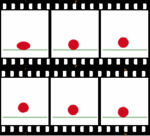User:JCY007/sandbox
 | This is a user sandbox of JCY007. You can use it for testing or practicing edits. This is not the sandbox where you should draft your assigned article for a dashboard.wikiedu.org course. To find the right sandbox for your assignment, visit your Dashboard course page and follow the Sandbox Draft link for your assigned article in the My Articles section. |
Animation is a method in which pictures are manipulated to appear as moving images. In traditional animation, images are drawn or painted by hand on transparent celluloid sheets to be photographed and exhibited on film. Today, most animations are made with computer-generated imagery (CGI). Computer animation can be very detailed 3D animation, while 2D computer animation can be used for stylistic reasons, low bandwidth or faster real-time renderings. Other common animation methods apply a stop motion technique to two and three-dimensional objects like paper cutouts, puppets or clay figures.
Commonly the effect of animation is achieved by a rapid succession of sequential images that minimally differ from each other. The illusion—as in motion pictures in general—is thought to rely on the phi phenomenon and beta movement, but the exact causes are still uncertain. Analog mechanical animation media that rely on the rapid display of sequential images include the phénakisticope, zoetrope, flip book, praxinoscope and film. Television and video are popular electronic animation media that originally were analog and now operate digitally. For display on the computer, techniques like animated GIF and Flash animation were developed.
Animation is more pervasive than many people realise. Apart from short films, feature films, animated gifs and other media dedicated to the display of moving images, animation is also heavily used for video games, motion graphics and special effects. Animation is also prevalent in information technology interfaces.[1]
The physical movement of image parts through simple mechanics – in for instance the moving images in magic lantern shows – can also be considered animation. The mechanical manipulation of puppets and objects to emulate living beings has a very long history in automata. Automata were popularised by Disney as animatronics.
Animators are artists who specialize in creating animation.
Part C[edit]
Mechanical animation[edit]
- Animatronics is the use of mechatronics to create machines that seem animate rather than robotic.
- Audio-Animatronics and Autonomatronics is a form of robotics animation, combined with 3-D animation, created by Walt Disney Imagineering for shows and attractions at Disney theme parks move and make noise (generally a recorded speech or song).[2] They are fixed to whatever supports them. They can sit and stand, and they cannot walk. An Audio-Animatron is different from an android-type robot in that it uses prerecorded movements and sounds, rather than responding to external stimuli. In 2009, Disney created an interactive version of the technology called Autonomatronics.[3]
- Linear Animation Generator is a form of animation by using static picture frames installed in a tunnel or a shaft. The animation illusion is created by putting the viewer in a linear motion, parallel to the installed picture frames.[4] The concept and the technical solution were invented in 2007 by Mihai Girlovan in Romania.
- Chuckimation is a type of animation created by the makers of the television series Action League Now! in which characters/props are thrown, or chucked from off camera or wiggled around to simulate talking by unseen hands.[5]
- The magic lantern used mechanical slides to project moving images, probably since Christiaan Huygens invented this early image projector in 1659.
Bibliography[edit]
- Encyclopedia, Britannica. "Animation". Dave Kehr. Retrieved 21 March 2019.
- Pilling, Jayne (1997). Society of Animation Studies (ed.). A Reader in Animation Studies. Indiana University Press. ISBN 978-1-86462-000-9.
- Parent, Rick (2007). Computer Animation: Algorithms & Techniques. Ohio State University: Morgan Kaufmann. ISBN 978-0-12-532000-9.
- Kenyon, Heather (1 February 1998). "How'd They Do That?: Stop-Motion Secrets Revealed". Animation World Network. Retrieved 2 March 2016.
- O'Keefe, Matt (11 November 2014). "6 Major Innovations That Sprung from the Heads of Disney Imagineers". Theme Park Tourist. Retrieved 9 March 2016.
Citations[edit]
Possible Chuckimation Citations[edit]
Gutenberg Chuckimation[6]
Different Types of Animation[7]
I believe the above cite for gutenberg could prove a better citation as it seems to be from a possible scholarly article. It provides slightly more detailed information than provided in the Animation wiki article. The website is black listed, but the information there did have a citation. Trying to find the information in that citation to use in place of this one.
The article above for student world online is a popular article that seems to stem from an academic source making the information provided slightly more credible. The information also seems to be analysis of the from of animation compared to the original cite used in the Animation article. That cite seems to be a simple mention of chuckimation from an animator who worked on a film using the style, but the animator never really spoke of what's involved too much.
- note*- The information on chuckiation is quite limited in terms of its description or finding it present in articles, but there has been discovery of its use in other films aside from the one mention in the wiki animation article, in which the work and is linked to. I believe there is more extensive information to be found and I will continue to search.
- ^ Buchan, Suzanne (22 August 2013). Pervasive Animation. Routledge. ISBN 9781136519550 – via Google Books.
- ^ Pilling 1997, p. 249.
- ^ O'Keefe 2014.
- ^ Parent 2007, pp. 22–23.
- ^ Kenyon 1998.
- ^ * Gutenberg, Project. [blacklisted "Chuckimation"]. World Heritage Encyclopedia. Retrieved 27 March 2019.
{{cite web}}: Check|url=value (help) - ^ * Online, StudentWorld. "6 Different Types of Animation". Student World Online. Retrieved 27 March 2019.


